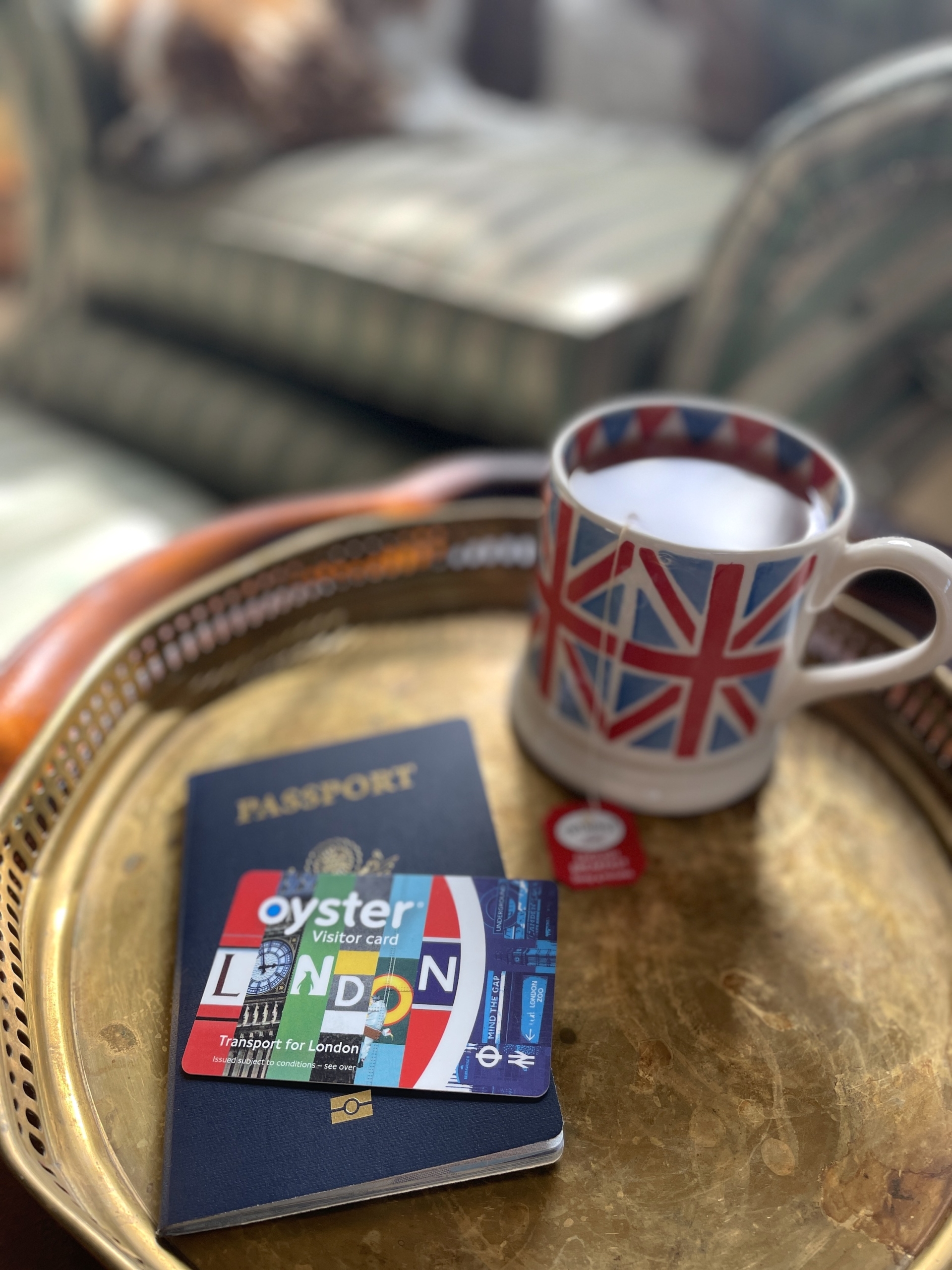Become a Member for as little as $4/mo and enjoy unlimited reading of TSLL blog.
Before heading to London for the first time in 2012, the husband of one of my dear friends (he being British but now living in the states yet visiting Britain often) gave me his Oyster card. At first I looked at him quizzically – What is an Oyster card?
I quickly learned it was the key to ease of travel about the city, and as I discovered almost immediately, having that card on me when I arrived (instead of having to figure out where to buy one upon arrival), reduced quite a bit of stress after a long day of travel and trying to find my accommodations in the city.
I returned with gratitude his Oyster card when I returned two weeks later, and have since purchased my own, and it is almost as important to my travel excursions to London as my passport (clearly, not the same thing, but you get the idea).
The Oyster card enables you to travel on more than just the Tube (London’s Underground – aka as the subway or metro), as you may also use it for train or bus transportation as well.

Today I would like to share with you 16 tips I’ve discovered for using The Tube to get about the city of London during your next visit. Having the opportunity to visit the city three different times (2012, 2017 and just recently in April 2022), I find the Tube to be the best way, and least expensive way, to move about the city to all of the sites, destinations, restaurants and locales I want to see.
Now I know you can also use the bus to make your way about the city, and this too is quite inexpensive. And when you use the bus you can see the city as you make your way to your next destination. I have yet to hop aboard the double-decker red busses, and hope to soon, but my election of using the Tube has more to do with swift transport – no traffic jams or delays, and using something again and again that understand. The Tube was the first mode of transport I learned to use in the city, and thus I feel most comfortable with it.
Let me share what I have learned that will ensure ease of travel as you move about the city of London.
1.Buy, Use and ReFill Your Visitor Oyster Card
Prior to leaving for London, purchase a Visitor Oyster card as seen in the pictures at the top of the post and just below. It will be shipped directly to you and look like any card you have in your wallet. I purchased mine prior to my trip in 2017, put a bit over the minimum on it when I purchased it (minimum is £5), and upon arriving in London filled it further as I needed to in the station (you can also do so at various shops around London – all detailed here).
I keep this Oyster card with me for each trip, and this past April used it to bustle about London as I had money remaining on it from my previous trip (it does not expire), and then topped it off at one of the stations.
There are so many benefits to using the Oyster card rather than Visitor Travel Tickets, and the ease of use – simply tapping your card to the yellow circle at the turnstiles when you enter and exit makes for ease of travel.
- Price capping – travel as much as you like; your card will automatically cap at the best daily fare, allowing you to travel stress-free across the capital.
- Use your card at Heathrow and Gatwick Airports – Simply use your Visitor Oyster card to get from these airports to central London and back.
- Night Tube: Travel all night on Fridays and Saturdays on the Victoria, Jubilee and most of the Central, Northern and Piccadilly line. Note: services are currently suspended with no firm date to resume.
As shared in the list above, you can also use your Oyster card to take the train from the airport to London – from Heathrow it will cost £20 when a cab would cost about £80.

2. Use the many resources the Tube website offers to plan your trip
In the past I only used my phone and Google Maps which will tell me exactly which station to enter that is closest to me which stops to ride through and which to get off, but I am now going to start using the Tube’s App (Tfl Go: Live Tube, Bus & Rail). You can also use their website to plan your trip with ease.

The Tfl Go app for The Tube, Train and Bus
3. Once you are through the turnstiles look for the colour of your line
The first thing I do is look for the color of my Tube line as each line/train has its own designated color. The color will also be paired with the name of the line you are looking for.

4. Don’t hesitate to print out and keep a map of the Tube with you (and look at it as you need to)
The first thing I did in 2012 was utilize the map I was given by the family we stayed with in Maida Valle. I wanted to make sure I had a physical source, and this also eliminated draining my phone battery. Once I had my lines and directions down, I didn’t need it anymore, but keep it with me just in case.
What I appreciate about The Tube throughout London is the clear communication via maps everywhere, names of lines and stops as well seemingly everywhere and easy signage in the tunnels guiding you as you are walking to your platform. Their goal is to get you where you want to go, and I have never once felt discombobulated or lost, even during my first trip over ten years ago.
~download a version of the Tube map below here

5. Look at the end stop of the line you are taking – this determines the direction of the train
Most, but not all trains, will go to the last stop on the line. When you are in the Tube station, most stations list all of the stops on large signage, in order, but not all. They will however, always share the last stop that line is heading towards (which determines an east or west/south or north direction). You want to make sure you are headed in the right direction, so know the last stop on the Tube train you are taking, and follow those signs to the platform.
6. Note if your line Splits, and check the end stop for your particular train
If you are using the app, this will be easy, and it will tell you which end stop you need to look for. But just be aware, as mentioned in #4, that some trains do split and have different end stop even if they begin going in the same direction.
7. Look for the White Circle on the Map to see where you can change trains
Again, using the App or Google Maps will eliminate your need to worry about this, but it does help to know what these White Circles are on the map. Simply put, they let you know that at that particular station, you can change trains to access the other lines on the map that cross at that White Circle. All of this is done underground, and you just follow the signs (color and end destination) to your new platform without having to use your Oyster card again.
8. Don’t crowded the platform waiting for the train
This is two-fold. I prefer to walk further down on the platform to avoid congestion, but you must first let the travelers on the train that are exiting do so before you enter, so stand back from the yellow line near the edge.
9. As the famous saying goes, heed it – Mind the Gap!
During my first trip to London in 2012, it was no joke to hear the saying by the automated telecom reminding passengers to “Mind the Gap” multiple times during the trip. The Gap, for those who have not traveled on the Tube is the space between the train and the platform which is a couple of inches at most stops. You understandably, do not want to step into that and become stuck, thus the reminder.
10. Stand on the Right, Walk on your Left
The escalators in the tube stations, especially at the heart of the city of London are loooooooong, and dive deep into the underground. If you are standing on the escalators, stay on the right. If you are walking, do so on the left.
11. Be prepared to give up your seat
If we are so fortunate, we are in good health and able to stand, and while taking a seat is absolutely acceptable, if the train is full, you will need to give up your seat to those in need of sitting down. Use your good sense, but simply standing and opening up a seat will invite someone who may need it. While most Londoners, if not all, will not say anything if you don’t get up and an expectant mother or a mother or father with a young child or anyone else who would like a rest, it will not go unnoticed, so be aware and politely without saying anything, stand up until your stop.
12. Don’t rush the door when your station is the next stop
Don’t worry, there will be enough time to get off, and most likely, many of your fellow travelers are getting off at your stop (and if not, they will make room for you to pass). Move to the door once the train has come to a stop at your station. There is usually a brief pause between the stopping of the train and the doors opening.
13. Keep your handbag or any items you are carrying with you on your lap (if seated)
If you are sitting down, be sure not to take up more than one seat, the one in which you are sitting.
14. Only use a Contactless credit/debit card if you will not incur additional fees
A new ability for traveling on London’s public transportation is to use contactless cards, which most debit and credit cards have (you will see three graduating arches – small and gray – on your card if your card has this capability, sometimes you have to activate, so check with your bank). They function the same as an Oyster card, simply hover them over the yellow circle at the turnstiles; however, sometimes you will incur a bank fee each time you use them, so it can be more expensive than an Oyster card. Simply check with your bank.
15. If traveling at night, note the Night Tube Map
There are five lines that operate overnight and all-night on Fridays and Saturdays which run until 4:29am. Read this article from VisitLondon for more details.
- Victoria Line – Trains every 10 minutes
- Jubilee Line – Trains every 10 minutes
- Piccadilly Line (Cockfosters to Heathrow Terminal 5 ONLY) – Trains every 10 minutes
- Northern Line (Camden Town to Morden) – Trains every 8 minutes
- Northern Line (Camden Town to High Barnet) – Trains every 15 minutes (No Night Tube on the Bank and Mill Hill East Branches)
- Central Line (White City to Leytonstone) – Trains every 10 minutes
- Central Line (Leytonstone to Loughton/Hainault) – Trains every 20 minutes
- Central Line (Ealing Broadway to White City) – Trains every 20 minutes (No Night Tube on other branches of the line)

16. See if you need to take the Tube. Walking can sometimes be easier.
Once you feel comfortable in the Tube, you may prefer taking it no matter how short the journey, but again, there is money you could save if you walk. Check out the physical map of the city or your app or Google Maps and see if walking on foot would be swifter and doable. It will likely be very enjoyable as there is much to see. However, if it’s raining, you may want to hop on the Tube. During Rush Hour and being in the heart of the city at any of the stations such as Charing Cross, Piccadilly Circle, Covent Garden, Leicester Square, and Embankment can become quite busy. I don’t mind this as I feel very safe and know where I am going, but if you will be walking a short distance and don’t want the bustle of oodles of people, you may want to avoid these stations.
Whenever you return or visit for the first time the city of London, I am confident you will be able to move about with ease seeing what you are looking forward to visiting, experiencing and enjoy. And don’t forget to Mind the Gap! 🙂

Discover all of the British Week ’22 posts Shared So Far

episode #329: 20 Life Lessons Learned During My Recent Trip to England
Discover all of the posts from Previous British Weeks here on TSLL








Shannon I did not need to read this but I did and your knowledge of the London underground is impressive . If I didn’t know you I would have thought you worked for London transport?. Even as a seasoned user of the underground over many years I have to admit mixing up my stations in a rush a few times. Once, I did not need the Mind the Gap announcement and lost one of my shoes in the gap?. I might add avoid Saturday rush hour at Knightsbridge . When exiting the underground make sure you take heed of the correct exit otherwise you might end up at the opposite end of the street instead of where you want to be and then you’ll have to retrace your steps. Now I need to find my oyster card collection somewhere in my handbag. Xx
Kameela,
Now I will take your compliment because as you shared, you’ve lived and worked and used the Tube for many years. 🙂 And thank you for the additional tip about exiting. That is great advice. 🙂
A great compilation of useful information for anyone planning a trip to London and likely using the Tube.??
Shannon, having lived in London for awhile in my 20’s, I would add to try travelling outside peak times. It can be a scrum and much nicer later in the day. A brilliant guide though for the visitor. X
This will be very helpful for anyone visiting London Shannon , you have compiled it so well ??⭐️
Although I live in the UK , I rarely travel to London, and always tackle the Tube with a bit of apprehension !
x Anne x
I agree, it really is the best way to get around the city. I was a little nervous at first since I find other subway systems intimidating (looking at you NYC LOL) but I had no trouble at all. Anyone planning a trip to London, don’t be shy, its affordable and easy to use.